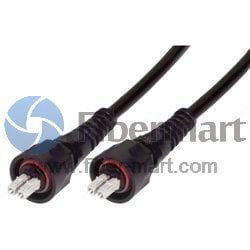An Ethernet cable is one of the most popular forms of network cable used on wired networks. Ethernet cables connect devices together within a local area network, like PCs, routers, and switches.
Given that these are physical cables, they do have their limitations, both in the distance that they can stretch and still carry proper signals, and their durability. This is one reason there are different types of Ethernet cables; to perform certain tasks in particular situations.
What an Ethernet Cable Looks Like
There's a picture of a few Ethernet cable ends on this page. It resembles a phone cable but is larger and has more wires.
Both cables share a similar shape and plug but an Ethernet cable has eight wires and a larger plug than the four wires found in phone cables.
Ethernet cables of course plug into Ethernet ports, which again, are larger than phone cable ports. An Ethernet port on a computer is accessible through the Ethernet card on the motherboard.
Ethernet cables come in different colors but phone cables are usually just grey.
Types of Ethernet Cables
Ethernet cables normally support one or more industry standards including Category 5 (CAT5) and Category 6 (CAT6).
A crossover cable is a special type of Ethernet cable specially designed for connecting two computers to each other. By contrast, most Ethernet cables are designed to connect one computer to a router or switch.
Ethernet cables are physically manufactured in two basic forms called solid and stranded.
Solid Ethernet cables offer slightly better performance and improved protection against electrical interference. They're also more commonly used on business networks, wiring inside office walls, or under lab floors to fixed locations
Stranded Ethernet cables are less prone to physical cracks and breaks, making them more suitable for travelers or in home networking setups.
Limitations of Ethernet Cables
A single Ethernet cable, like an electric power cord, has a limited maximum distance capacity, meaning they have an upper limit to how long they can be before signal loss (called attenuation) happens. This is due to their electrical transmission characteristics and is directly affected by interference around the cable.
Both ends of the cable should be close enough to each other to receive signals quickly, but far enough away from electrical interferences to avoid interruptions. However, this alone doesn't limit the size of a network because hardware like routers or hubs can be used to join multiple Ethernet cables together within the same network. This distance between two devices is called the network diameter.
The maximum length of a single CAT5 cable, before attenuation occurs, is 324 feet. CAT6 can go up to around 700 feet. Keep in mind that Ethernet cables can be longer but they might suffer from signal loss, especially if there are other electrical appliances that the cable passes by.
Note: Ethernet cable length is a little different if you're talking about thin, 10 base 2, or thick, 10 base 5 cables.
The former should be no longer than 600 feet while the latter cable type should be able to reach lengths of around 1,640 feet.
Also consider that a short cable may suffer from reflection. However, some users have reported no problems with cable lengths as low as even 4 inches.
Several different types of RJ-45 connectors exist. One type, designed for use with stranded cables, generally is incompatible with solid cables. Other types of RJ-45 connectors may work with both stranded and solid cables.
See Is It Safe to Run Ethernet Cables Outdoors? if you're wanting to do that.
Alternatives to Ethernet Cables for Computer Networking
Wireless technologies like Wi-Fi and Bluetooth have replaced Ethernet on many home and business networks.












No comments have been posted yet.